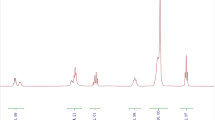Abstract
A class of novel cationic Gemini imidazolium surfactants containing amide groups as the spacer were synthesized from ethylenediamine and 1-bromoalkane(C8, C10, C12, C14, C16) by N-alkylation to get N,N′-dialkyl ethylenediamine (1a–e), 1a–e was further reacted with chloroacetyl chloride by N-acylation to get N,N′-(ethane-1,2-diyl)bis(2-chloro-N-alkylacetamide) (2a–e), which was further reacted respectively with 1-methyl imidazole by quaternized to form the surfactant molecule, N,N′-((ethane-1,2-diyl)bis(alkyl-azanediyl)bis(2-oxoethane-2,1-diyl)) bis(1-methyl-1H-imidazol-3-ium) dichloride. The structures of intermediates (1a–e) and (2a–e) were characterized by IR and 1H NMR. The structures of the surfactants (3a–e) were characterized by IR, 1H-NMR and 13C-NMR and element analysis. The critical micelle concentrations (CMC) of 3a–e were determined by the conductivity method at 25 °C. The CMC values decreased with increasing the length of the hydrophobic chain. The surfactants (3a–e) showed good foaming stability, emulsion ability and wetting ability. The surfactants (3a–e) also have good antimicrobial activity against Staphylococcus aureus, Escherichia coli and Bacillus subtilis.


Similar content being viewed by others
References
Kamboj R, Singh S, Bhadani A, Kataria H, Kaur G (2012) Gemini imidazolium surfactants: synthesis and their bio physiochemical study. Langmuir 28:11969–11978
Tehrani-Bagha AR, Holmberg K (2010) Cationic ester-containing Gemini surfactants: physical–chemical properties. Langmuir 26:9276–9282
Wattebled L, Laschewsky A (2007) Effects of organic salt additives on the behavior of dimeric (“Gemini”) surfactants in aqueous solution. Langmuir 23:10044–10052
Laschewsky A, Wattebled L, Arotcarena M, Habib-Jiwan JL, Rakotoaly RH (2005) Synthesis and properties of cationic oligomeric surfactants. Langmuir 21:7170–7179
Hu DH, Guo XF, Jia LH (2013) Synthesis, surface active properties of novel Gemini surfactants with amide groups and rigid spacers. J Surfactant Deterg 16:913–919
Bernd T (2005) Polymerisation of styrene in microemulsion with catanionic surfactant mixtures. Colloid Polym Sci 283:421–430
Bell PC, Bergsma M, Dolbnya IP (2003) Transfection mediated by Gemini surfactants: engineered escape from the endosomal compartment. J Am Chem Soc 125:1551–1558
Zana R (2002) Dimeric and oligomeric surfactants. Behavior at interfaces and in aqueous solution: a review. Adv Colloid Interface Sci 97:205–253
Bhadani A, Kataria H, Singh S (2011) Synthesis, characterization and comparative evaluation of phenoxy ring containing long chain Gemini imidazolium and pyridinium amphiphiles. J Colloid Interface Sci 361:33–41
Ao M, Xu G, Zhu Y, Bai Y (2008) Synthesis and properties of ionic liquid-type Gemini imidazolium surfactants. J Colloid Interface Sci 326:490–495
Ao M, Huang P, Xu G, Yang X, Wang Y (2009) Aggregation and thermodynamic properties of ionic liquid-type Gemini imidazolium surfactants with different spacer length. Colloid Polym Sci 287:395–402
Perez L, Pinazo A, Rosen MJ, Infante MR (1998) Surface activity properties at equilibrium of novel Gemini cationic amphiphilic compounds from arginine, Bis (Args). Langmuir 14:2307–2315
Aiad I, Emam D, EI-Deeb A, Abd-Alrahman E (2013) Novel imidazolium-base Gemini surfactants: synthesis, surface properties, corrosion inhibition and biocidal activity against sulfate-reducing bacteria. J Surfactant Deterg 16:927–935
Zhao W, Li Q, Xie X, Deng J (2012) Advances in antifungal activity of heterocyclic amide compounds. J Jilin Agric Sci 37:52–58
Singh S, Bhadani A, Kataria H, Kaur G, Kamboj R (2009) Synthesis of glycerol-based pyridinium surfactants and appraisal of their properties. Ind Eng Chem Res 48:1673–1677
Hoque J, Kumar P, Aswal VK, Haldar J (2012) Aggregation properties of amide bearing cleavable Gemini surfactants by small angle neutron scattering and conductivity studies. J Phys Chem B 116:9718–9726
Stjerndah M, Holmberg K (2005) Synthesis, stability, and biodegradability studies of a surface-active amide. J Surfactants Deterg 4:331–336
Lif A, Hellsten M (1998) Nonionic surfactants containing an amide group. In: van Os NM (ed) Nonionic surfactants, organic chemistry, vol 72. Marcel Dekker, New York, p 177
Zhang J, Xiao G (2011) Study progress in nitrogenous heterocyclic compounds. Petrochem Technol 6:579–584
Ahmad I, Patial P, Kaur C, Kaur S (2014) Cationic imidazolium monomeric surfactants: their synthesis and surface active properties. J Surfact Deterg 17:269–277
Talmage Syliva S (2004) Environmental and human safety of major surfactant. Lewis Publishers, Boca Raton
Mao P (1988) Synthetic detergent industrial analysis. The Publishing House of Light Industry, Peking, pp 456–462
Zhang D, Fan W, Zhao M (2001) Quick calculation of determining surface tension in drop volume method. China Surfact Deterg Cosm 1:49–50
American Society for testing and materials (2005) standard evaluation test method for of wetting agents by the skein test D 2281-68
Xu J, Liu X, Wang B, Qiao Z (2010) Synthesis and characterization of sodium N,N′-dioctyl-ethylene-diaminediacyl propionate. Int J Chem 2:194–197
Garcia MT, Ribosa I, Perez L, Manresa A, Comelles F (2013) Aggregation behavior and antimicrobial activity of ester-functionalized imidazolium- and pyridinium-based ionic liquids in aqueous solution. Langmuir 29:2536–2545
Geng F, Liu J, Zheng LQ, Yu L, Li GZ, Tung CH (2010) Micelle formation of long-chain imidazolium ionic liquids in aqueous solution measured by isothermal titration micro calorimetry. J Chem Eng Data 55:147–151
Kuliszewska E, Brecker L (2014) Gemini surfactants foam formation ability and foam stability depends on spacer length. J Surfact Deterg. doi:10.1007/s11743-014-1582-5
Oh SG, Shah DO (1991) Relationship between micellar lifetime and foamability of sodium dodecyl sulfate and sodium dodecyl sulfate/1-hexanol mixtures. Langmuir 7:1316–1318
Acknowledgments
We thank the Science and Technology Fund of Heilongjiang Province of China (grant No. B201116), the Overseas Scholars Foundation of Scientific and Technical Agency of Heilongjiang province Foundation of China (No. LC2011C17), the Program for YJSCX Scientific Research in Heilongjiang province (grant No. YJSCX2013-ZD12) and the College Students’ Innovative Entrepreneurial Training Project of Heilongjiang province of China (201410221015).
Author information
Authors and Affiliations
Corresponding authors
About this article
Cite this article
Wang, L., Qin, H., Ding, L. et al. Preparation of a Novel Class of Cationic Gemini Imidazolium Surfactants Containing Amide Groups as the Spacer: Their Surface Properties and Antimicrobial Activity. J Surfact Deterg 17, 1099–1106 (2014). https://doi.org/10.1007/s11743-014-1614-1
Received:
Accepted:
Published:
Issue Date:
DOI: https://doi.org/10.1007/s11743-014-1614-1




